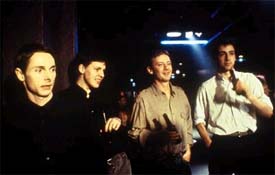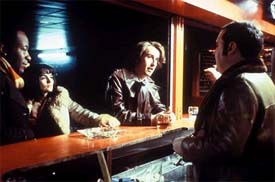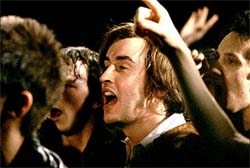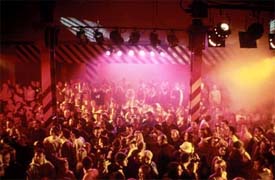
|
"Next time we knock ourselves out let's do it for something close to our hearts. . . like music." -- Anthony Wilson, 24 Hour Party People soundtrack liner notes.
In describing the soundtrack album, Wilson probably provides the most accurate analysis of the movie: "They are the songs which shape the film and they are the songs which shaped a few lives." Because the "film" and filmmakers so fully submit to the music's meaning and allure, the movie brings the music becomes close to spectators' hearts, too. 24 Hour Party People not only goes behind the scenes of the making of the music and the Factory label, it subverts the very presumptions about "behind-the-scenes" documentary the same way that the post-punk artists subverted rock ideology. Shot by cinematographer Robby Muller, 24 Hour Party People toys with the presumed documentary realism of the digital video image. In the movie, Wilson exalts the technique: "Free play of signs and signifiers!" With the impending DV turnover, this is incredibly potent stuff - a wake-up call not unlike that of Joy Division, satirically named after a Nazi rape squad. Joy Division, later to meta-morph into New Order, is the band that highlights the first chapter of the movie. (The "second act" announced by Wilson focuses on The Happy Mondays, the band whose raging good-time song provides the movie's title, and their reign at La Hacienda in the early '90s.)
One amazingly poignant pop memory conjured by 24 Hour Party People is the genius of Ian Curtis, the frontman for Joy Division. His automaton stage movements - inspired by his epilepsy and his empathic art and social consciousness - are enthrallingly recreated by Sean Harris, an actor inspired. Quote Wilson in the movie: "The dangers and wonders of semiotics that is the musical equivalent of Che Guevara." Even the expressionist funeral march following Curtis' suicide in 1980 is a genuine postmodern spectacle: critiquing pop stardom while being scored to the unshakably moving "Atmosphere."
Coogan does more than any "behind-the-scenes" documentary could do to convey the hedonistic, intelligent excitement of participating in three daredevil (note the movie's Icarus prologue) pop epochs: punk, post-punk, and the rave scene. Making witty asides to the camera, Coogan not only exposes the artifice of the medium, he invites the movie audience to join in the radical fun. The self-conscious mythmaking - that's the fun - had by Coogan, Winterbottom, and Curtis, however, is best when expanding to inscribe a sense of responsibility as spectators/participants. The most powerful montage in 24 Hour Party People counterpoints a recreated Joy Division performance of "Radio Transmission" with contemporaneous television news footage of the fascist National Front strikes. Questioning ideas about history and History, this sequence marks "24 Hour Party People" as the most profound use of DV in a narrative movie that I know.
This daring sociological footnote honors the "beautification of the beat" and the audience "applauding the medium" - as Coogan's Wilson defines it - that rave culture instigated in contrast to the pop-star effigy of the post-punks. Through Winterbottom's own challenging and fresh use of the digital medium, the spectator must constantly locate the context of the music - and of themselves as movie watchers. "Dance, dance, dance" to the digital transmission. A helicopter shot of a benighted Manchester is accompanied by The Happy Mondays' "Hallelujah!" 24 Hour Party People recognizes pop as both socio-economic "double helix" (one trend replacing the next) as well as spiritually double-edged. That's the dangers and wonders of pop. |
|
© 1997-2002 BEI
The sexual orientation of individuals pictured in and writers for
Gay Today should not be assumed.
 24 Hour Party People Sean Harris, Tim Horrocks, John Simm and Ralf Little
24 Hour Party People Sean Harris, Tim Horrocks, John Simm and Ralf Little  Peter Kay, Shirley Henderson,
Peter Kay, Shirley Henderson,  Steve Coogan as Tony Wilson
Steve Coogan as Tony Wilson  In another mockumentary sequence, Winterbottom quickly elucidates the
connection between the popularity of The Happy Mondays' proto-rave music at
La Hacienda with the proliferation of the drug trade - and drug violence.
In another mockumentary sequence, Winterbottom quickly elucidates the
connection between the popularity of The Happy Mondays' proto-rave music at
La Hacienda with the proliferation of the drug trade - and drug violence.